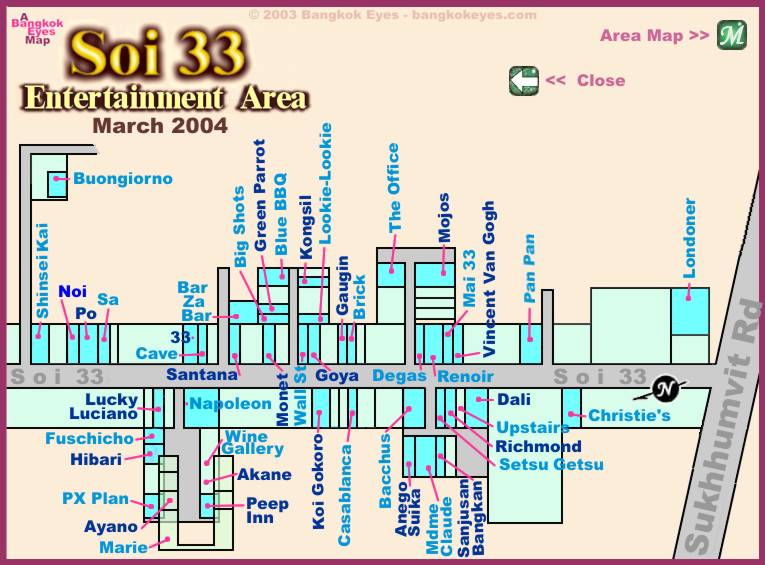
Thumbnail History - Soi 33 (Soi Dead Artists)
Updated April 2002
- Richard D. Hartman
In 1987 the Renoir opened in Soi 33 ; it would be the first of several bars named after Impressionist painters. But the second to move into Soi 33 , in 1988, was the ever-popular Pan Pan Italian Restaurant . Although it is a family restaurant and not a Night Entertainment Venue per-se, it deserves special mention here as it has contributed perhaps more than any other venue to the popularization of Soi 33 with the expatriate community.
Following closely on the heels of the Pan Pan Italian Restaurant in that same year was a second Impressionist painter lounge, the Vincent Van Gogh . It and the Renoir were “testing the waters”; would, up-market lounges work here on Soi 33 as they had in the Patpongs ? The obvious and overwhelming success of lounges like the Napoleon on Patpong 1 and the Crown Royal on Patpong 2 made it seem to be well worth a try.
By 1991, there were a handful of lounges, including the Monet , EA Manet Club and the Degas , which continued the Impressionist theme and the slightly more expensive, up-market lounge format. Growth of the Entertainment Area was almost imperceptibly slow in these ‘early’ years, but it was undeniably sure. By 1992, there were enough lounges in operation on Soi 33 to establish critical mass; the baby would survive and continue to grow. The Ea Manet Club was the only Impressionist bar to have faded from the scene (by mid-1990’s).
It was at this juncture that the Soi 33 Night Entertainment Area became known variously as; the “Artist’s Soi” , the “Painter’s Soi” and the slightly irreverent “Soi Dead Artists” by its regulars. There is no quorum; these nicknames and variations thereof are all in use today.
But the original question of the viability of up-market lounges in a previously ‘out-of-the-way’ location had been answered: proof of concept was at hand. The handshake and the appellation of ‘seminal bars’ can be divided equally between the pioneers Renoir and the Vincent Van Gogh ; they set the tone, they took the gamble, they survived and prospered. These two lounges along with the Monet, Degas and others are not only still in business today, they often find themselves packed out on weeknights as well as the weekends.
Although many of the newer lounges on Soi 33 are not named after ‘Dead Artists’, some did carry on, at least in spirit, with the tradition. In addition to the four ‘Impressionist’ lounges mentioned above, there are the relatively recent ‘painter’ additions Goya , Dali and the Santana .
But this is not the end of the story. At the beginning of 1999 there were 16 establishments on Soi 33 that could call themselves Night Entertainment Venues. At the turn of the Millennium there were 20. Today, (April 2002) there are 32, which is two more than currently found on Patpong 1 , even if you include in the count Patpong 1 ’s marginal upstairs ‘pay-for-show’ places. Nevertheless, any way you slice it, this relatively recent growth is more than “imperceptibly slow”; this is a quiet explosion. To be sure, due to the size of the Entertainment Area, this relatively large number of bars is not immediately apparent to the first-time visitor. Among the expatriate Entertainment Areas, Soi 33 is the biggest, area-wise. While the entire Soi 33 is longer, the Entertainment Area itself is about 350 meters long and has four short lanes, or sub-sois, each having at least one Entertainment Venue.
No discussion of the Soi 33 Entertainment Area would be complete without the inclusion of the Japanese contingent. The first Japanese bar in the area was the Entertainment Club Fuchicho . This name might ring a bell with a few of the longtime residents and return visitors to Bangkok. It is the eventual reincarnation of the Club New Fuchicho , which was one of the pioneers of Nana Plaza ’s second floor. This newly established Entertainment Club Fuchicho settled in the then-recently constructed Peep Inn complex deep in Soi 33 , and was to set the trend for Japanese bars for several years; virtually all the earlier bars were located therein. Later on, the Japanese bars would spread out along Soi 33 , to include the Kosu Mosu at the extreme North end of the Entertainment Area. Their growth has kept pace with Soi 33 growth in general; in December of 2000, when the 33 Complex opened on Soi 33 across from the original Renoir , several of the new leases went to Japanese owned/operated establishments. This compound is now home to several new lounges and includes Setsu Getsu KKA , Suika, and Sanjusan Bangkan Karaoke . Of the 32 Night Entertainment Venues on Soi 33 , nine are Japanese.
In that Soi 33 is exclusively low-key Lounge format and not A-Go-Go, it will likely weather the current Purachaiian storm of moral indignation better than many of the other expat Night Entertainment Areas. If the last two years’ rate of new openings continues unabated, it won’t be long before Soi 33 is Bangkok's largest Night Entertainment Area in every sense.
© 2001, Bangkok Eyes / bangkokeyes.com
* With grateful acknowledgement to Zootramp Publications for exclusive use of their historical database.
